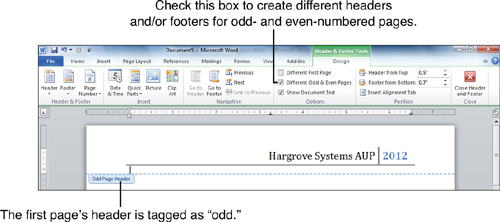Creating Different Headers or Footers for Odd and Even Pages
You can set up different
headers and/or footers for your document’s odd and even pages. That way,
the odd-numbered pages get their own header or footer, and the
even-numbered pages get a different one. Here’s how to do it:
1. | Create the header or footer for the first (odd-numbered) page.
|
2. | On
the Design tab, click the Different Odd & Even Pages check box to
place a check mark in it. Word changes the first page’s header and
footer tags to read “Odd Page Header” and “Odd Page Footer,” as shown in Figure 1.

|
3. | Go to the second (even-numbered) page and set up a different header or footer for it.
|
To jump between the header
and footer on the same page, use the Go to Header and Go to Footer
buttons.
To move from the header or footer on one page (whether odd- or
even-numbered) to the next page, click the Next button on the Design
tab. To move to the header or footer on the previous page, click the
Previous button.
Hiding the Header or Footer on a Document’s First Page
It’s pretty common for a
document to have headers or footers on all but the first page. If you’re
writing a multipage memo, for example, it may look funny to have a
header on the first page along with all the To, From, and other lines
that usually reside at the top of the page.
You can hide (suppress) the header and footer on a document’s first page. Here’s how:
1. | Double-click a header or footer to switch to Header and Footer view. The Design tab appears.
|
2. | In
the Options group of the Design tab, click the Different First Page
check box to place a check mark in it. Word removes the header and/or
footer from the document’s first page but not from the remaining pages.
|
3. | Click the Close Header and Footer button.
|
The Different First Page
option also enables you to create a header for the first page that is
different from the headers on the document’s other pages. To create a
different first-page header, select the Different First Page check box;
then click in the first page’s header area. Create a new header. This header appears only on the first
page; the remaining headers remain unchanged.
Removing a Header or Footer from a Document
If you decide that your document doesn’t need a header or footer after all, you can remove it. Here’s how:
- To remove a header, go to the Insert tab, click the Header button, and then click Remove Header.
- To remove a footer, go to the Insert tab, click the Footer button, and then click Remove Footer.